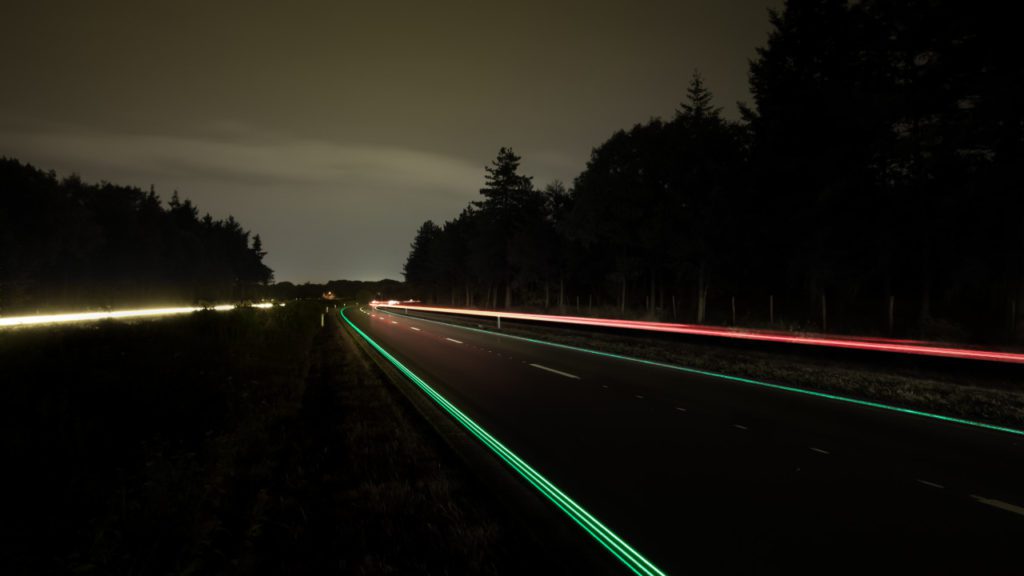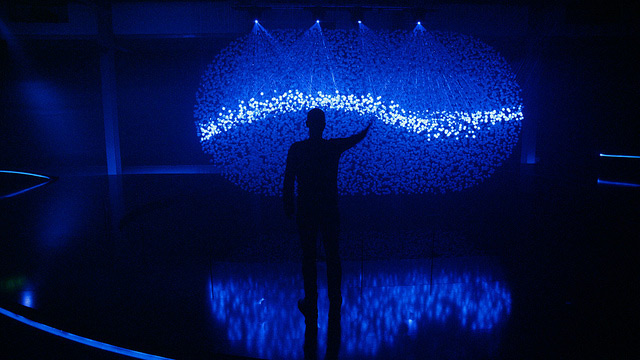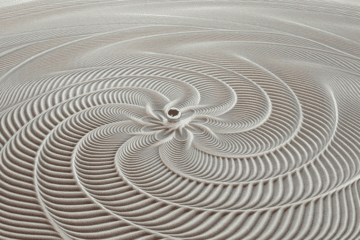This blog post is going to walk you through some of the interactive light art installations.
Volume – SOFTlab

Volume is an interactive cube of responsive mirrors that redirect light and sound to spatialize and reflect the excitement of surrounding festival goers. The installation is made of a grid of 100 mirrored panels that each rotate individually. An array of depth cameras above track people as they move around the installation. Using a weighted average of the various people being tracked the mirrors rotate to face the nearest person. Individually addressable LEDs along the sides of the mirrored panels respond to the ambient sound in the space around the installation.
The installation redraws the line between what is considered ephemeral vs. physical as the installation remixes space and the character of the festival goers while gazing back at them with empathy and exuberance.
Megastructure – Marcus Lyall

Megastructure is a site-specific installation for Bluedot Festival 2018, Jodrell Bank Observatory. It is an interactive installation that aims at turning the passive structure that receives radio waves into an installation that emits radio waves. People could control the pattern of the projection onto the installation by waving hands at the switch. This project shows the juxtaposition of a small thing such as a switch that could control a megastructure.
Interactive Whirlpools – TeamLab

Japanese art collective TeamLab has used lighting to create a sea of spiralling whirlpools inside a Melbourne art museum. Designed to look like whirlpools in water, the installation is created from “immersive and responsive” lights that project moving lines on the floor. These lights are programmed to respond to the presence and movement of people in the room.
“When a person moves, a force is applied in that direction. As a result, a flow occurs,” explained the designers.
“The faster the person moves, the stronger the force is applied in that direction,” they said. “If a person is not moving or there are no more people, no flow will occur and nothing will be present in the space.”
Embodiment – Eric Franklin

Portland-based sculptor Eric Franklin constructs stunning (if not slightly disconcerting) anatomical light structures that are fully hollow and filled with ionized krypton, causing them to glow similar to a neon light. The glass skeleton above, Embodiment, is my jaw-dropping favorite of this series. The piece took over 1,000 hours of work over a two year period and is actually built from 10 separate units of glass formed from borosilicate glass tubing.
This project is not very “interactive” in a sense, but it is just so beautiful and dazzling. And it took a long time to build, as the artist stated himself:
Every glass seal has to be perfect, and this piece contains hundreds. Everywhere one tube joins another, or a tube terminates, glass tubes were sealed together. They have to be perfect in order to preserve the luminosity of the krypton. If one rogue molecule gets inside the void of the glass tubing it can eventually contaminate the gas and it will no longer glow. There are times when the holes in the seals are so small that you cannot actually see them with your eyes without the help of a leak detector. Once the glass pieces are ready to get filled with gas, I pull a high vacuum while the glass is hot in order to evacuate any dust or water vapor from the interior surface until there are literally no molecules inside the void of the glass. Then the krypton can be introduced and the glass sealed off. It’s an extremely tedious process, one I have somewhat of a love/hate relationship with.
Eric Franklin

Glowing Lines – Daan Roosegaarde

https://studioroosegaarde.net/project/smart-highway
GLOWING LINES charge during day-time and glow at night to create an iconic highway experience and increase safety. The project is part of the SMART HIGHWAY.
The first GLOWING LINES have been realised after a trial period of 3 months in the Netherlands, and glows up to eight hours at night. The project exhibited for 3 years in Oss, NL. GLOWING LINES will further be developed and launched internationally.
SMART HIGHWAY are interactive and sustainable roads of tomorrow by Daan Roosegaarde and Heijmans Infrastructure. Its goal is to make smart roads by using light, energy and information that interact with the traffic situation. SMART HIGHWAY consists of projects Electric Priority Lane, Dynamic Paint, Glowing Lines, Interactive Light, Road Printer, and Wind Light.
Firewall – Aaron Sherwood
Firewall is an interactive media installation created by Aaron Sherwood with Mike Allison. A stretched sheet of spandex acts as a membrane interface sensitive to depth that people can push into and create fire-like visuals as well as expressively play music.
The piece was made using Processing, Max/MSP, Arduino and a Kinect. The Kinect measures the average depth of the spandex from the frame it is mounted on. If the spandex is not being pressed into nothing happens. When someone presses into it the visuals react around where the person presses, and the music is triggered. An algorithm created with Max allows the music to speed up and slow down and get louder and softer, based on the depth. This provides a very expressive musical playing experience, even for people who have never played music before. A switch is built into the frame which toggles between two modes. The second mode is a little more aggressive than the first.
FLUIDIC: Sculpture in Motion – Advanced Design Center & WHITEvoid

https://www.whitevoid.com/fluidic/
The interactive light sculpture is made from 12,000 suspended spheres that act as three dimensional pixels, or voxels. Surrounded by 3D cameras the piece can sense viewer’s motions which are then translated into light patterns, but amazingly the light supplied to the individual voxels is fully external. An array of high-speed lasers project into the cloud to create the dynamic visuals in real-time.
A seemingly floating point cloud above a water pond and consisting of 12,000 translucent spheres marks the heart of the installation. Due to a complex computer algorithm the spheres are arranged seemingly random within the cloud. At the same time the algorithm observes the positions and projection angles of eight high-speed laser projectors that are being arranged around the artwork. They are sending out beams scanning through the arrangement of the cloud. Generating bright and dim light points, this creates a highly organic and natural distribution of voxels (3D pixels). Emerging lines and shapes finally form graphical compositions without any sweet or blind spots. Keeping the same density and intensity the FLUIDIC graphics enables their viewers to observe and interact with it from every point of view.
WHITEvoid



0 Comments